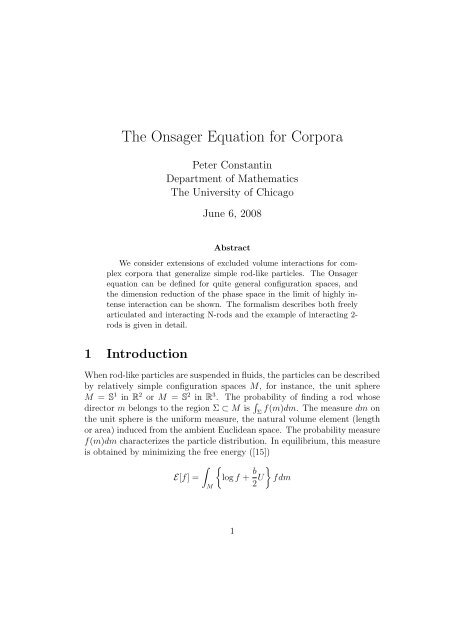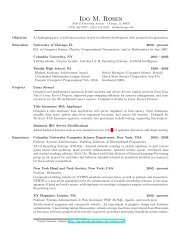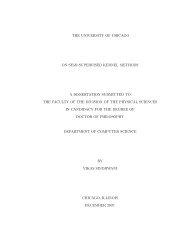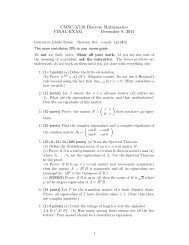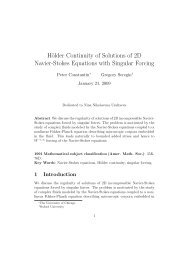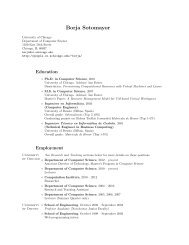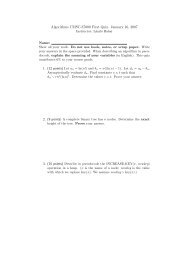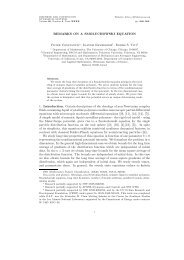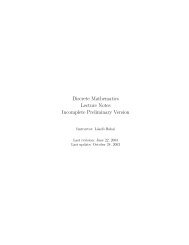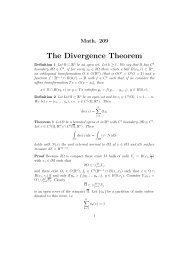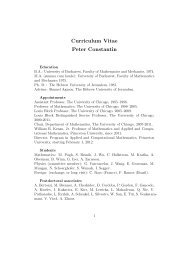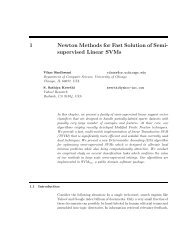The Onsager Equation for Corpora - Department of Mathematics
The Onsager Equation for Corpora - Department of Mathematics
The Onsager Equation for Corpora - Department of Mathematics
Create successful ePaper yourself
Turn your PDF publications into a flip-book with our unique Google optimized e-Paper software.
where b is a nonnegative parameter, representing a combination <strong>of</strong> inversetemperature and intensity <strong>of</strong> interaction, and∫U(m) = u(m, p)f(p)dpMis a potential computed from an interaction kernel u(m, p). <strong>The</strong> physicalmodeling is reflected in the choice <strong>of</strong> kernel. Only two effects are taken intoaccount in the free energy: an entropic effect, representing thermal fluctuation<strong>of</strong> the particles, and a quadratic mean field effect representing excludedvolume interactions between particles. <strong>The</strong> description <strong>of</strong> the problem iscompleted by specifying the configuration space M, the uni<strong>for</strong>m measure dmand the interaction kernel u. Once these are determined we may ask questions,such as: do minima <strong>of</strong> the free energy exist, how many such minimaexist, what happens to them as the parameter b varies from b = 0 to infinity.In the case <strong>of</strong> more complicated corpora, the configuration space M canbe rather complicated. We use the word “corpus” to refer to a body thathas finitely many degrees <strong>of</strong> freedom, such as an assembly <strong>of</strong> articulatedrods, or rods connected to balls <strong>of</strong> different sizes and with different motionconstraints between the parts. <strong>The</strong> collection <strong>of</strong> all corpora <strong>of</strong> a particularproblem is the configuration space. It is useful to phrase the equilibrium andkinetic problems broadly, in quite general configuration spaces. We consider ametric space M, with distance d, and assume we are given a Borel probabilitymeasure µ on M. This probability measure corresponds to the normalizeduni<strong>for</strong>m distribution <strong>of</strong> corpora m ∈ M, and M is the configuration space.For absolutely continuous probability Borel measures ν
Because ∫ Ufdµ = ∫ ∫u(x, y)f(x)f(y)dµ(x)dµ(y), there is no loss <strong>of</strong>M M Mgenerality by assuming that u(x, y) is symmetric, as only the symmetric part1(u(x, y) + u(y, x)) contributes to the free energy. Critical points <strong>of</strong> the free2energy obeyδEδf = 0which leads to <strong>Onsager</strong>’s equation:f = Z −1 e −bU (2)Indeed, this follows taking the Gateaux derivative (i.e. the first variation) <strong>of</strong>E in a direction h, i.e.ddt E[f + th] | t=0 = 0,with arbitrary h, subject only to ∫ hdµ = 0 in order to respect ∫ (f +M Mth)dµ = 1. A simple calculation, using the fact that u(x, y) is symmetric inx, y leads to ∫ (log f + bU)hdµ = 0 <strong>for</strong> all h. This implies that log f + bU isMconstant µ-almost everywhere. Because u is Lipschitz continuous, it is easyto see that the solutions <strong>of</strong> (2) are Lipschitz continuous, positive and nevervanish.<strong>The</strong> kernel u gives the rule to construct the potential U associated to theparticle distribution ν = fdµ; in examples this is computed from physicsand it instructs the particles to con<strong>for</strong>m to each other. As b → ∞ thereare phase transitions. In the abstract case where we have a distance d wemay consider general u(x, y) = Φ(d(x, y), x, y) and the simplest examplesare u(x, y) = d(x, y) p with p = 1, 2 or u(x, y) = −e − d2 (x,y)l 2 . <strong>The</strong> interactionpotential u(x, y) should have a minimum at x = y.2 Rods<strong>The</strong> simplest example <strong>of</strong> single rods has M = S 1 . <strong>The</strong> <strong>Onsager</strong> kernel isu(θ 1 , θ 2 ) = | sin(θ 1 − θ 2 )|, and the Maier-Saupe kernel isu(θ 1 , θ 2 ) = − cos 2 (θ 1 − θ 2 ).Kernels are defined up to addition <strong>of</strong> constants, so the Maier-Saupe kernelcan be taken as u(θ 1 , θ 2 ) = − cos(2(θ 1−θ 2 ))2.3
Throughout this paper we will use the notation Kf = −U[f] = −U toemphasize the linear dependence <strong>of</strong> U on f. (<strong>The</strong> minus sign is a conventionwe maintain to be consistent with previously published literature.)In the Maier-Saupe potential case, Kf projects f on the eigenspace <strong>of</strong>the Laplace-Beltrami operator corresponding to eigenvalue 4. If the functionf is written asf(θ) = 12π + 1 ∞∑y j cos(2jθ) (3)πthen Maier-Saupe potential isj=1Kf = 1 2 y 1 cos(2θ). (4)<strong>The</strong> solutions <strong>of</strong> the <strong>Onsager</strong> equation in that case are <strong>of</strong> the <strong>for</strong>mwithand in Fourier representationg(r) = (Z(r)) −1 e r cos(2θ) (5)Z(r) =∫ 2πg(r)(θ) = 12π + 1 π0e r cos(2θ) dθ (6)∞∑g j (r) cos(2jθ) (7)<strong>Onsager</strong>’s equation is equivalent to the implicit transcendental equationj=1g 1 (r) = 2rb . (8)If b ≤ 4 this equation has one solution, namely r = 0. If b > 4 there isexactly one more solution <strong>for</strong> r > 0 at r = r(b). <strong>The</strong>re is exactly one solution<strong>for</strong> r < 0, at r = −r(b) corresponding to a rotation <strong>of</strong> π <strong>of</strong> the solution with2r > 0. It is known also that g 0 (r) = 1 <strong>for</strong> all r,g j (r) > 0, g j+1 (r) < g j (r), j ≥ 1, r > 0. (9)If r = r(b) is determined by (8), theng 2 (r(b)) = 1 − 4 b ,4
there are recursion relations to compute all g j (r), anddbdr = b2 ( )g22r 1 − g 2 > 0 (10)holds <strong>for</strong> the inverse function, b(r). This is an increasing unbounded function<strong>for</strong> b > 4. <strong>The</strong> stability <strong>of</strong> the solution g(r) also follows from the inequalityg 2 1 − g 2 > 0. Both the inequality and the stability are not obvious. <strong>The</strong> limit<strong>of</strong> zero temperature is a delta function:lim g (r(b))(θ)dθ = δ 0 . (11)b→∞<strong>The</strong> choice <strong>of</strong> θ = 0 is dictated by the symmetry θ ↦→ −θ that we imposed.Otherwise, we obtain any delta function on the circle. <strong>The</strong> case <strong>of</strong> S 2 withMaier-Saupe potential is similar. <strong>The</strong> potential projects on the eigenspace <strong>of</strong>eigenvalue 6 <strong>of</strong> the Laplace-Beltrami operator on the sphere. Two implicittranscendental equations determine the solution. <strong>The</strong>re is a finite temperaturephase transition and the zero temperature limits are delta functions onpoints or geodesics.3 Kinetics<strong>The</strong> kinetic description <strong>of</strong> rod-like particles ([9]) can be naturally generalizedwhen the configuration space M is a Riemannian manifold. When M isRiemannian manifold, the kinetic equations are∂ t f = ∆ g f − bdiv g (f∇ g (Kf)) (12)with ∆ g , div g , ∇ g Laplace-Beltrami, divergence and gradient in M, Kf givenby∫Kf = − u(m, p)f(p)dµ(p) (13)Mand the uni<strong>for</strong>m measure dµ is the Riemannian volume element. Note thatthe equation can be written as∂ t f = div g (f∇ g (log f − bKf))<strong>The</strong> solutions are smooth, positive and normalized so they have unit integral.<strong>The</strong> free energy∫E ={f log f − b }2 fKf dµ (14)5
is a Lyapunov functional:∫ddt E = − f |∇ g (log f − bKf)| 2 dµ(p)MIf M is connected, the only possible steady solutions are solutions <strong>of</strong> <strong>Onsager</strong>’sequationf = Z −1 e bKf . (15)<strong>The</strong> dynamical system is dissipative: the solutions are bounded after aninitial transient time. <strong>The</strong> bounds, in very strong norms, are independent <strong>of</strong>the initial data. <strong>The</strong> global attractor is compact, finite dimensional and is<strong>for</strong>med with solutions <strong>of</strong> <strong>Onsager</strong>’s equations and their unstable manifolds.In the case <strong>of</strong> M = S 1 with Maier-Saupe potential, the kinetic equations aregiven by the sequence <strong>of</strong> ODEsddt y j = −4j 2 y j + bjy 1 (y j−1 − y j+1 ) . (16)<strong>The</strong> equations on S 2 are more complicated. Some <strong>of</strong> the results concerningequilibria and kinetics <strong>for</strong> the Maier-Saupe potential can be found in [1] -[4],[6], [7], [10] -[14] and [19]. Recently it was shown that the system has inertialmanifolds in both S 1 and S 2 ([17]-[18]).4 Freely articulated corporaWe consider corpora made <strong>of</strong> N articulated rods that are allowed to rotatefreely. <strong>The</strong> configuration space is ˜M = S n × · · · × S n with n = 1 or 2. <strong>The</strong>potential is a sum <strong>of</strong> binary interactionsv(p 1 , q 1 , p 1 , q 2 , . . . p N , q N ) =N∑u j (p j , q j ). (17)j=1<strong>The</strong> uni<strong>for</strong>m measure µ on ˜M is the product measure. In this situation, thecorresponding solution <strong>of</strong> the <strong>Onsager</strong> equation is a product measureν(dp 1 . . . dp N ) = Π N j=1Z −1j e −bU j(p j ) dp j (18)where each Z −1j e −bU j(p j ) is a solution <strong>of</strong> <strong>Onsager</strong>’s equation in the j component,and everything can be reduced to the study <strong>of</strong> individual rods. This6
∫ 2πZ = e −b sin2 (θ)+2bz sin θ−bγ dθ0<strong>The</strong> solution is f(p 1 , p 2 ) = g(p 1 − p 2 ). Note that g does not depend on γ.Let thens(θ, z) = sin θ − z,and let∫ 2πs(θ, z)e −bs2 (θ,z) dθ0[s](b, z) = ∫ 2π.e0 −bs2 (θ,z)dθ<strong>The</strong> <strong>Onsager</strong> equation is equivalent to[s](b, z) = 0. (19)This determines z, which in turn determines g, f. Note that z = 0 always asolution that yieldsf 0 (p 1 , p 2 ) = Z −1 e −b sin2 (p 1 −p 2 ) .As b → ∞ this solution tends to δ((p 1 − p 2 ) modπ), a degenerated two-rod.Consider nowwith τ = b −1 . Note thatso (19) is equivalent toλ(z, τ) = b 1 2∫ 2π0e −b(sin θ−z)2 dθ[s](τ −1 , z) = 1 ∂ z λ2b λ∂ z λ = 0. (20)Note also that λ solves a linear heat equation with temperature as time:∂ τ λ = 1 4 ∂2 zλ<strong>The</strong> function λ is even in z, so it is enough to study it on [0, 1]. <strong>The</strong> “initialvalue” obeys, <strong>for</strong> any z ∈ [0, 1),lim λ(z, τ) = 2√ 1π √τ→0 1 − z29
<strong>for</strong> all x ∈ M, and all r sufficiently small. Here B(x, r) is the ball centeredat x ∈ M and <strong>of</strong> radius r in the metric d. This assumption says thatall balls are charged at least a small positive amount. Note that if M isany compact Riemannian manifold <strong>of</strong> dimension n and µ is the Riemannianvolume element, then the condition (21) is automatically satisfied, because r nis much larger, <strong>for</strong> small r, than the right hand side <strong>of</strong> (21). <strong>The</strong> interactionkernel we consider is a function <strong>of</strong> the distance, u(d(x, y)), so∫U(x) = u(d(x, y))f(y)dµ(y). (22)MWe assume that u is non-negative, bounded and Lipschitz continuous, i.e.there exist positive constants C and L so thatandhold <strong>for</strong> all d, d 1 , d 2 ≥ 0. We assume also that0 ≤ u(d) ≤ C (23)|u(d 1 ) − u(d 2 )| ≤ L |d 1 − d 2 | (24)u(0) = 0. (25)As we mentioned be<strong>for</strong>e, the interaction kernels are defined up to additiveconstants: if we add c to the interaction kernel, then the potential is changedby the same amount c and the free energy is changed by adding bc ; its critical2points, and in particular its minima are unchanged. Let us take a ball <strong>of</strong> B<strong>of</strong> radius r, set χ = µ(B) −1 1 B the normalized indicator function <strong>of</strong> B, andcomputeE[χ] = log(µ(B) −1 ) + b ∫ ∫2 µ(B)−2 u(d(x, y))dµ(x)dµ(y)We obtain, using (21, 23, 24) that( ) k ( )1 1E[χ] ≤ + log + bLrr cwhich implies, by choosing r = b −1 , thatBBinff E[f] ≤ bk + C 111
holds <strong>for</strong> large b with some constant C 1 . This means that uni<strong>for</strong>m measure,whose energy is linear in b,E[1] = b ∫ ∫u(d(x, y))dµ(x)dµ(y)2MMdoes not achieve the minimum <strong>of</strong> energy <strong>for</strong> large b. On the other hand,<strong>for</strong> may examples, the uni<strong>for</strong>m measure is a solution <strong>of</strong> <strong>Onsager</strong>’s equation.Indeed, if T is a µ measure preserving isometry <strong>of</strong> M, then the potentialassociated to the uni<strong>for</strong>m measure µ, U[1] = −K1, is invariant under rightcomposition with T , i.e.,U(T x) = U(x)holds <strong>for</strong> all x ∈ M and all measure preserving isometries. If measure preservingisometries act transitively, i.e., <strong>for</strong> any x, y ∈ M there exists T ameasure preserving isometry that maps x to y, y = T x then, U = −K(1) isa constant. This implies that the uni<strong>for</strong>m measure is a solution <strong>of</strong> <strong>Onsager</strong>’sequation. This is the case <strong>for</strong> many homogeneous spaces. <strong>The</strong> combination <strong>of</strong>these two very simple observations leads to the conclusion that a phase transitionoccurs, whenever the homogeneous measure is a solution <strong>of</strong> <strong>Onsager</strong>’sequation, the condition (21) holds and the interaction kernel is a normalizedLipschitz function <strong>of</strong> distance. That simply means that, while <strong>for</strong> b = 0 obviouslythe only solution <strong>of</strong> <strong>Onsager</strong>’s equation is the homogeneous measure,and while this continues to be a solution <strong>for</strong> b > 0, at large enough b thereexist other solutions as well, in quite great generality.Now we describe a general tendency <strong>of</strong> solutions to concentrate. Letdν = fdµ be any probability measure absolutely continuous with respect toµ and let U be the potential associated to it via (22). <strong>The</strong>n, in view <strong>of</strong> theproperty (23) we have0 ≤ U(x) ≤ C (26)and from (24) and the triangle inequality we deduce that|U(x) − U(y)| ≤ Ld(x, y) (27)so that the potentials associated to any probability fdµ are non-negative,uni<strong>for</strong>mly bounded and Lipschitz continuous.<strong>The</strong>orem 1 Let M be a compact metric space with distance d. Let µ be aBorel probability measure on M that satisfies (21). Let u satisfy (23,24).<strong>The</strong>n:12
(A) For any b > 0 there exists a solution g that minimizes the enery:E[g] =minf>0, R E[f]M fdµ=1<strong>The</strong> function g solves the <strong>Onsager</strong> equationwithandg(x) = (Z(b)) −1 e −bU(x)∫Z(b) =∫U(x) =MMe −bU(x) dµ(x)u(d(x, y))g(y)dµ(y)<strong>The</strong> function g is normalized ∫ gdµ = 1, strictly positive and Lipschitz continuous.(B) Let b n → ∞ and let dν n = g n dµ be a sequence <strong>of</strong> solutions <strong>of</strong> <strong>Onsager</strong>equations corresponding to b n . By passing to a subsequence we may assumethat the sequence converges weakly to a probability measure ν = lim n ν n .<strong>The</strong>re exists a non-negative Lipschitz continuous function U ∞ (x) on M suchthat ν is concentrated on the setΣ = {x ∈ M | U ∞ (x) = min y∈M U ∞ (y)}Thus, <strong>for</strong> any continuous function φ supported in the open set M \ Σ,∫φ(x)g n (x)dµ = 0limn→∞MPro<strong>of</strong>. For the pro<strong>of</strong> <strong>of</strong> (A) we fix b > 0 and note that E[f] is bounded belowuni<strong>for</strong>mly <strong>for</strong> all f > 0, ∫ fdµ = 1. We take then a minimizing sequenceMf j ,a = inff>0; R E[f] = lim E[f j ].M fdµ=1 j→∞Without loss <strong>of</strong> generality, by passing to a subsequence and relabelling, wemay assume that the measures f j dµ converge weakly to a measure dν. Using(26, 27) and the Arzela-Ascoli theorem, we may pass to a subsequence, whichwe relabel again f j , so that U j converge uni<strong>for</strong>mly to a non-negative Lipschitzcontinuous function U. <strong>The</strong>n it follows that∫U(x) = u(d(x, y))dν(y)M13
holds and∫∫lim U j f j dµ = Udν.j→∞MMBecause E[f j ] is a convergent sequence <strong>of</strong> numbers, it follows that∫limj→∞Mf j log f j dµexists. In particular, the above integrals are bounded uni<strong>for</strong>mly. It thenfollows that dν is absolutely continuous i.e., dν = gdµ, with g ≥ 0, g ∈L 1 (dµ). Indeed, the sequence f j dµ is uni<strong>for</strong>mly absolutely continuous. Thisfollows from the convexity <strong>of</strong> the function y log y and the Jensen inequality∫(µ(A)) −1 f log fdµ ≥ m log mwhere m = µ(A) ∫ −1 fdµ. <strong>The</strong>n we haveAAm log m ≤ C/µ(A)with a fixed constant C > 0, uni<strong>for</strong>mly <strong>for</strong> all f = f j and any A. Let uschoose R so that R log R = C/µ(A). If we denote by I = ∫ fdµ, then eitherAm ≤ R, or, if not, then m log R ≤ C/µ(A). In either case the inequalitiesimplyI ≤ C/ log(R)and as µ(A) → 0, R → ∞. This inequality signifies∫f n dµ ≤ δ(µ(A))Awith lim x→0 δ(x) = 0 and δ(x) independent <strong>of</strong> n. This implies that ν is absolutelycontinuous, ν = gdµ with 0 ≤ g ∈ L 1 (dµ). <strong>The</strong> weak convergencetested on the function 1 implies that ∫ gdµ = 1. In general, weak convergence<strong>of</strong> measures is not enough to show lower semicontinuity <strong>of</strong> nonlinearintegrals or almost everywhere convergence. We claim however that in factthe convergence f n → g takes place strongly in L 1 (dµ):∫limn→∞M|f n (x) − g(x)|dµ(x) = 0.14
In order to prove this we prove that f n is a Cauchy sequence in L 1 (dµ). Wetake ɛ > 0 and choose N large enough so thatand∫∣Msup |U n (x) − U(x)| ≤ ɛ2x∈M10b ,U(x)(f n (x) − f m (x))dµ∣ ≤ ɛ210bE[f n ] ≤ a + ɛ216hold <strong>for</strong> n, m ≥ N. Let s(x) = 1(f 2 n(x) + f m (x)). <strong>The</strong>n ∫ sdµ = 1, s > 0,Msoa ≤ E[s].<strong>The</strong>re<strong>for</strong>e12 {E(f n) + E(f m )} − E[s] ≤ ɛ216 .On the other hand,∫ { 12 [f n log f n + f m log f m ] − s log s}dµ ≤ 1 2 {E(f n) + E(f m )} − E[s] + ɛ216soM∫M{ 12 [f n log f n + f m log f m ] − s log s}dµ ≤ ɛ2 8 .Denote χ = fn−fmf n+f mand note that −1 ≤ χ ≤ 1 holds µ - a.e. Also, elementarycalculation show that{ 12 [f n log f n + f m log f m ] − s log s}= s 2 G(χ)holds with( 1 + χG(χ) = log(1 − χ 2 ) + χ log1 − χ(Note that G is even on (−1, 1), that G ′ (χ) = logand G ′′ (χ) = 21−χ 2≥ 2 on (−1, 1). Consequently,0 ≤ χ 2 ≤ G(χ)151+χ1−χ).), G(0) = G ′ (0) = 0
holds <strong>for</strong> −1 ≤ χ ≤ 1. It follows that we have∫(f n − f m ) 2dµ ≤ ɛ2f n + f m 2MBut, writing |f n − f m | = √ |ff n + f n−f m|m√ fn+fmand using the Schwartz inequalitywe deduce∫|f n − f m |dµ ≤ ɛ.M<strong>The</strong>re<strong>for</strong>e the sequence f n is Cauchy in L 1 (dµ). This proves that the weaklimit f n dµ → gdµ is actually strong f n → g in L 1 (dµ). By passing to asubsequence if necessary, we may assume also that f n → g holds also µ- a.e.<strong>The</strong>n, from Fatou’s Lemma∫∫g log gdµ ≤ lim f j log f j dµ.j→∞This implies thatME[g] = a.<strong>The</strong> fact that g solves the <strong>Onsager</strong> equation follows by taking the Gateauxderivative, and thusg = Z −1 e −bUwith Z = ∫ M e−bU dµ. Because U is bounded it follows that g never vanishesand because U is Lipschitz, so is g.<strong>The</strong> pro<strong>of</strong> <strong>of</strong> (B). Let b n → ∞ and let us take a subsequence so that g n dµconverges weakly to dν. As above, because <strong>of</strong> (26, 27) and the Arzela-Ascolitheorem, we may pass to a subsequence, which we relabel again g n , so thatU n converge uni<strong>for</strong>mly to a non-negative Lipschitz continuous function U ∞ .Let x n be a point where U n (x) attains its minimum U n (x n ) = min x∈M U n (x).By passing again to a subsequence we may assume that x n converge to somepoint x. It follows that that U ∞ (x) = min m∈M U ∞ (m) = α. Let φ be acontinuous function in M compactly supported in M \ Σ where Σ = {m ∈M | U ∞ (m) = α}. <strong>The</strong>re exists ɛ > 0 so that, <strong>for</strong> every m in the support <strong>of</strong>φ, U ∞ (m) ≥ α + 4ɛ. Let us take N so large that sup M |U ∞ (m) − U n (m)| ≤ ɛ<strong>for</strong> n ≥ N and d(x n , x) ≤ ɛ Denote α L nthe minimum <strong>of</strong> U n . It follows that|α n − α| ≤ 2ɛ and U n (m) ≥ α n + ɛ on the support <strong>of</strong> φ. On the other hand,we have∫∫Z n (b n ) ≥ e −bnUn(z) dµ(z) ≥ e −bnαn e −bnLd(z,xn) dµ(z),B(x n, 1bn ) B(x n, 1bn )16
and using (21) we get<strong>The</strong>re<strong>for</strong>e, on the support <strong>of</strong> φ we haveZ n (b n ) ≥ e −L ce −bk n e−b nα n(28)g n (m) = (Z n (b)) −1 e −bnUn(m) ≤ e L c −1 e bk n eb nα ne −bn(αn+ɛ)and consequently∫∫∣ φ(m)g n (m)dµ(m)∣ ≤ eL c −1 e bk n e−b nɛMholds, and there<strong>for</strong>e, as k < 1 we have∫φg n dµ = 0.7 Conclusionslimn→∞MM|φ(m)|dµ(m) (29)<strong>The</strong> generalization <strong>of</strong> excluded volume interactions, from simple rod-like particlesto complicated corpora leads to a “simple” equation (the <strong>Onsager</strong> equation)in “complicated” spaces. <strong>The</strong> examples <strong>of</strong> single rods, and articulatedtwo-rods show significant complexity reduction. <strong>The</strong> complexity reduction,once the problem is phrased correctly, is expected to be generic. <strong>The</strong> zerotemperature or high intensity limit <strong>of</strong> probability distributions <strong>of</strong> corporaconcentrates on the minima <strong>of</strong> certain Lipschitz functions, in general.8 AcknowledgmentsWork partially supported by NSF-DMS grant 0504213. I thank A. Zlatosand B. Farb <strong>for</strong> fruitful conversations.References[1] P. Constantin, Nonlinear Fokker-Planck Navier-Stokes Systems, Commun.Math. Sci. 3 (2005), 531-544.17
[2] P. Constantin, Smoluchowski Navier Stokes Systems, Contemporary<strong>Mathematics</strong> 429, G-Q Chen, E. Hsu, M. Pinsky editors, AMS, Providence(2007), 85 - 109.[3] P. Constantin, I. Kevrekidis, E. S. Titi, Remarks on a Smoluchowski<strong>Equation</strong>s, Discrete and Continuous Dyn. Syst, 11 (2004) 101-112.[4] P. Constantin, I. Kevrekidis, E.S. Titi, Asymptotic states <strong>of</strong> a Smoluchowskiequation, ARMA 174 (2004), 365-384.[5] P. Constantin, Ch. Fefferman, E.S. Titi, Global Regularity <strong>for</strong> Smoluchowskiequations coupled to fluids, article in preparation.[6] P. Constantin, E.S. Titi, J. Vukadinovic, Dissipativity and GevreyRegularity<strong>of</strong> a Smoluchowski <strong>Equation</strong>, Indiana U. Math J., 54 (2005),949-969.[7] P. Constantin, J. Vukadinovic, Note on the number <strong>of</strong> steady states <strong>for</strong>a 2D Smoluchowski equation, Nonlinearity 18 (2005) 441-443.[8] P. Constantin, A. Zlatos, <strong>The</strong> <strong>Onsager</strong> equation <strong>for</strong> articulated rods inspace, in preparation.[9] M. Doi, S.F. Edwards, <strong>The</strong> <strong>The</strong>ory <strong>of</strong> Polymer Dynamics, Ox<strong>for</strong>d UniversityPress, Ox<strong>for</strong>d 1988.[10] I. Fatkullin, V. Slastikov, A note on the <strong>Onsager</strong> model <strong>of</strong> nematic phasetransitions, Commun. Math. Sciences. 3 (2005), 21-.[11] H. Zhou, H. Wang, M.G. Forest, Q. Wang, A new pro<strong>of</strong> on axisymmetricequilibria <strong>of</strong> a three-dimensional Smoluchowski equation, Nonlinearity 18(2005) 2815-2825.[12] G. Forest, Q. Wang, R. Zhou, <strong>The</strong> weak shear phase diagram <strong>for</strong> nematicpolymers, Rheologica Acta, 43 (2004), 17-37.[13] C. Luo, H. Zhang, P-W. Zhang, <strong>The</strong> structure <strong>of</strong> the equilibrium solutions<strong>of</strong> one dimensional Doi equation, Nonlinearity 18 (2005), 379-389.[14] H. Liu, H. Zhang, P-W Zhang, Axial symmetry and classification <strong>of</strong>stationary solutions <strong>of</strong> Doi-<strong>Onsager</strong> <strong>Equation</strong> on the sphere with Maier-Saupe potential. Comm. Math. Sci. 3 (2005), 201-218.18
[15] L. <strong>Onsager</strong>, <strong>The</strong> effects <strong>of</strong> shape on the interaction <strong>of</strong> colloidal particles,Ann. N.Y. Acad. Sci 51 (1949), 627-659.[16] F. Otto, A. Tzavaras, Continuity <strong>of</strong> velocity gradients in suspensions <strong>of</strong>rod-like molecules, SFB Preprint 147 (2004).[17] J. Vukadinovic, Inertial Manifolds <strong>for</strong> a Smoluchowski equation on acircle, preprint (2008)[18] J. Vukadinovic, Inertial Manifolds <strong>for</strong> a Smoluchowski equation on theunit sphere, preprint (2008).[19] A. Zarnescu, <strong>The</strong>sis, the University <strong>of</strong> Chicago, (2006).19


